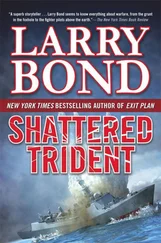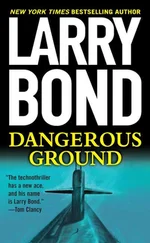A large blip appeared suddenly on his screen-close to the center, near
Pretoria-and then vanished as quickly as it had appeared. What the devil?
Was that a scheduled flight he’d forgotten about, or was his equipment acting up? The sergeant fumbled through his logbook while keeping one eye on the glowing radar screen.
More blips appeared-coming from the southeast this time and moving fast. He stared hard, trying frantically to get an accurate count. Five. Ten. More than twenty planes racing in from out of nowhere! He spun round in his chair, his eyes wide in alarm.
“Lieutenant!”
PROWLER LEAD, SOUTHEAST OF JOHANNESBURG
Ten miles behind the A-6 and F/A-18 attack squadrons, the EA-613 Prowler electronic warfare aircraft bounced and shook as it ploughed through choppy air. Rolling ridges and valleys emerged out of the darkness ahead and then blurred past and aft. Flying low at five hundred knots left little time for sightseeing.
One of the two officers seated side by side behind the pilot and navigator listened to a series of tones sounding in his earphones and watched as a signal intensity indicator climbed higher. He spoke into the intercom.
“SA
radar’s got us, Curt. “
“Right.” The pilot broke radio silence on the strike frequency.
“Tiger flights, this is Prowler Lead. They know we’re here. We’re lighting off.”
He clicked back to the intercom.
“Okay, guys, let’s do it. Radiate and blind those bastards.”
The two backseaters flipped a series of switches, activating the Prow)er’s
ALQ-99 jamming system. Current started flowing from windmill turbo generators on the three jamming pods slung beneath the EA-613’s fuselage. In seconds, the Prowler was punching kilowatts of power into the same frequencies used by South Africa’s air-search radars.
NORTHERN AIR DEFENSE HQ
“Shit! ” The blips on the flight sergeant’s radarscope vanished in a coruscating swirl of bright green blotches and a solid strobe line. He switched frequencies frantically and ineffectively. The jamming followed him across the wavelengthseffortlessly matching every shift.
After several failed tries, he stopped frequency-hopping and tried turning down the radar’s gain instead. It worked after a fashion. By trading range for visibility, he was able to break through the jamming . and see nothing.
The flight sergeant swore again. The bogies were outside his radar’s reduced range. He knew there were enemy aircraft over South Africa, but he couldn’t tell how many, where they were, or most important of all, where they were headed.
The Air Force lieutenant watching over his shoulder turned pale and grabbed a red phone by the radar console.
“Put me through to Number Three
Squadron!”
ABOARD SIERRA ONE ZERO, OVER PELINDABA
Lt. Col. Robert O’Connell took a deep breath, held it for a second, and let it out-trying to shake off a case of last minute jitters. Literally last minute, too, he thought. They couldn’t be much more flying time than that from the drop zone.
The drop zone was one of his concerns. Their need for total surprise had ruled out the use of pathfinders to mark the DZ. As a result, the aircraft carrying the Rangers were relying entirely on navigational data supplied by Navstar GPS Global Positioning System-satellites. The GPS program managers claimed their system was accurate to within a few feet, and O’Connell hoped like hell that they were right.
He staggered slightly and braced himself as the MC-141 began a steep climb, popping up to five hundred feet for its run over the Pelindaba complex. Any second now.
Without stopping to think much about it, O’Connell found himself muttering a prayer from his childhood.
“Hail Mary, full of grace, the Lord is with thee…”
As the MC-141 leveled out, its two side doors whined open and twin blast shields deployed to provide pockets of calm air outside the doors. Cold night air and howling engine noise swept through the crowded troop compartment. O’Connell watched as the plane’s jumpmaster leaned out through the open door, checked the shield and jump step, and made sure they were approaching the drop zone.
The jump light over the open cargo door flickered and went green.
“Go!
Go! GO!”
Conscious thought faded and thousands of hours of training and preparation took over. Rank by rank and row by row, the Rangers shuffled rapidly to the open side doors and threw themselves into empty air.
Five C-141s swept low over Pelindaba spewing out hundreds of Rangers and their equipment.
COMMAND BUNKER, 61 ST TRANSVAAL RIFLES, PELINDABA
Col. Frans Peiper spilled his mug of hot coffee onto the bunker’s concrete floor as his phone buzzed. He grabbed the phone on its second buzz. “
Pelindaba CO.”
He didn’t recognize the panic-stricken voice on the other end.
“Air raid warning! This is an air raid warning!”
“What?”
The roar of large aircraft passing directly overhead drowned out any reply.
Peiper dropped the phone and ran to one of the bunker’s firing slits, trying vainly to catch a glimpse of these attacking planes. Nothing.
Nothing. There! Something huge and black-more a shadow than a discernible shape-flashed past and disappeared beyond the eastern end of the compound. They were under attack!
He whirled and slammed a shaking hand down on the alert button.
Sirens screamed across the complex in a rising and falling wail designed to wake the dead, or in this case, the two thirds of Pelindaba’s garrison who were off duty and fast asleep in their barracks. At the same time, arc lights around the perimeter began winking out to deny incoming enemy bombers easy aiming points.
1/75TH RANGERS
More than five hundred men of the 1/75this three companies and its headquarters came drifting down out of the niSjIt sky into the Pelindaba atomic research and weapons storage complex. Some never made it farther than that.
Three Rangers, the first men out of the lead plane, landed too far to the west-outside the barbed wire and inside a minefield. One hit the ground and rolled right onto the pressure plate of an antipersonnel mine. A white-orange blast tore him in half and spewed fragments that scythed the other two paratroopers to the ground, bleeding and unconscious.
More Americans came down hard in the middle of Pelindaba’s ornamental rock gardens-breaking legs or arms or fracturing collarbones. Near the power substation, a Charlie Company sergeant slammed face first into a steel pylon at more than twenty miles an hour. The impact broke his neck and left his corpse draped across a steel girder forty feet off the ground.
Two groups of Rangers had the worst luck of all.
Six men landed in a tangle of billowing parachutes and loose gear on open ground-less than thirty feet away from mortar pits occupied by South
African troops who’d been on duty. The Americans were still struggling out of their chutes when a fusillade of automatic weapons fire mowed them down.
Four others came down right in the middle of a South African infantry squad patrolling inside the compound. Flames stabbed through the darkness as R4 rifles and M16s were fired at point-blank range. Seconds later, all four Americans and three of the South Africans lay dead. One of the
Rangers wore the silver eagle insignia of a full colonel over his chest pocket. Paul Gener, commander of the 75th Ranger Regiment, had made his last combat jump.
HEADQUARTERS COMPANY, 1/75TH RANGERS
Lt. Col. Robert O’Connell hit the ground with his legs bent and rolled-his hands already fumbling with the release catch for his parachute harness. A light wind tugged at his chute, threatening to drag him along through the open grassland between the research center and the weapons storage bunkers.
Читать дальше












